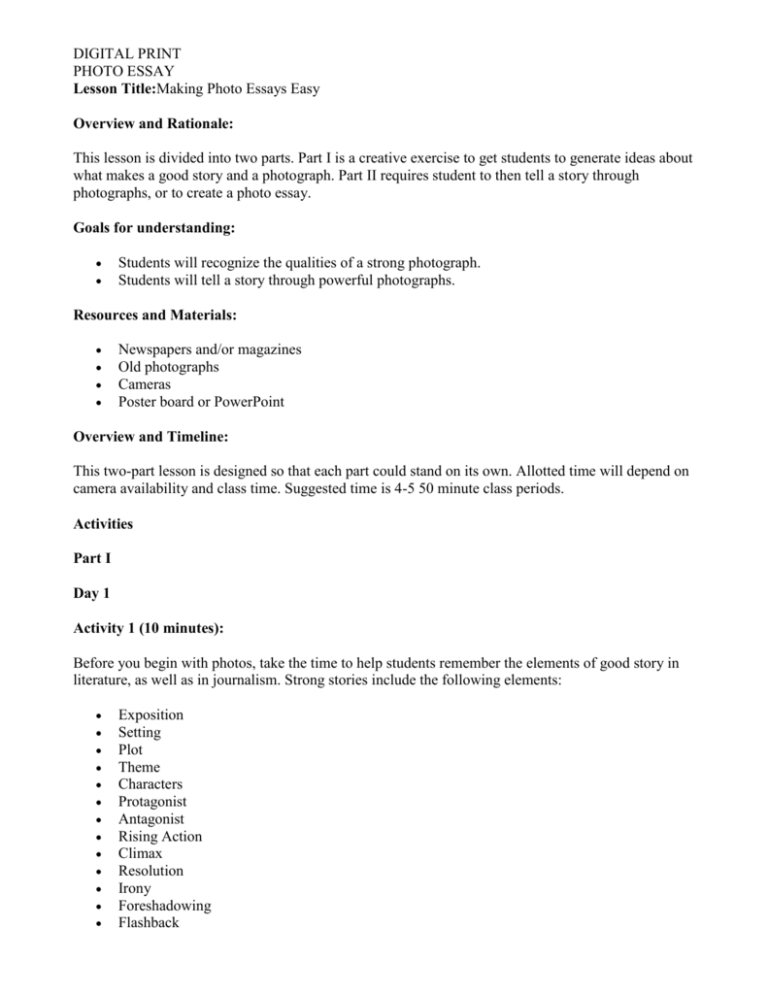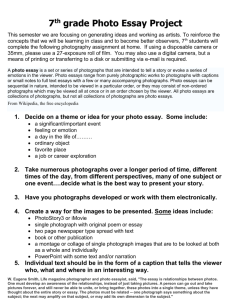Photo-Essay Assignment
advertisement

DIGITAL PRINT PHOTO ESSAY Lesson Title:Making Photo Essays Easy Overview and Rationale: This lesson is divided into two parts. Part I is a creative exercise to get students to generate ideas about what makes a good story and a photograph. Part II requires student to then tell a story through photographs, or to create a photo essay. Goals for understanding: Students will recognize the qualities of a strong photograph. Students will tell a story through powerful photographs. Resources and Materials: Newspapers and/or magazines Old photographs Cameras Poster board or PowerPoint Overview and Timeline: This two-part lesson is designed so that each part could stand on its own. Allotted time will depend on camera availability and class time. Suggested time is 4-5 50 minute class periods. Activities Part I Day 1 Activity 1 (10 minutes): Before you begin with photos, take the time to help students remember the elements of good story in literature, as well as in journalism. Strong stories include the following elements: Exposition Setting Plot Theme Characters Protagonist Antagonist Rising Action Climax Resolution Irony Foreshadowing Flashback DIGITAL PRINT PHOTO ESSAY Activity 2 (30-45 minutes): Using already published material, have groups of 4 students collect 10 or so photos and assemble them into a story. The results may be silly or serious; the object here is to have students create the story from photos they already have. The students will fix the photos to a poster board according to the story they created. Activity 3 (15 minutes): Their classmates will then try to figure out what story the photos are telling. The group will then share the story they came up with and they will discuss why they chose the photos they did. Save the presented stories for the next session. Day 2 Activity 1 (30 minutes): o Students identify the strongest photos in each story from previous day. In their groups they will generate a list of what they believe makes a good photo. This should get students thinking about: angles Perspective Composition framing lighting emotions details o Student will also discuss the following: How they were limited by working with photos that already exist? What photos had they wished were available? Was their story successful? Did it catch attention? Why or why not? Did the photos represent what was really happening in their stories? Activity 2 (20 minutes) o Students will then generate lists of what they think constitutes a good Selection or series of photos. This will be the spring board for telling them about effective photo essay elements, such as: varied perspectives varied distances angles changes in lighting Elements of the story that are not obvious to the reader. Focusing on different people involved Rule of thirds Variety of sizes and shapes of photos Dominant photographs o Find some examples of photo essays to share with the class. One example is: http://www.motherjones.com/ news/feature/2002/37/ma_111_01.html o To find others, use Google to search for "photo essays". Be sure to point out examples of the above topics. DIGITAL PRINT PHOTO ESSAY Photo-Essay Assignment http://members.efn.org/~hkrieger/vet.htm bob miller // photographer. visual journalist. http://www.digital-photography-school.com/5-photo-essaytips http://thephotoessay.com/ http://121clicks.com/inspirations/heart-touching-examplesof-documentary-photography/ Ihttp://stylishwebdesigner.com/45-awesome-examples-ofdocumentary-photography/ http://wsfcsintouch.blogspot.com/2008/12/convertpowerpoint-presentations-to.html The goal of this assignment is for you to create a Photo Essay that evokes emotion from those who view it—if you can inspire your audience to some kind of action you have succeeded. Just like a written essay, you should brainstorm a topic, gather information, and use that information in your essay – but your information will primarily be what’s provided through photographs. As well, you should plan your essay, organizing it with an introduction, body and conclusion. SOME SPECIFICS 1. Your photo-essay must relate to: a. The idea of community – community events, friends in the community, issues in the community b. A day life in the life of ---c. My family/My home d. GHS memories e. Themes such as silence, wonder, patience, dedication, allegiance, perseverance f. Geographical place like the front door or table in the café or library g. Date or event like Tuesday 10:00am or Halloween h. Social issue like teen pregnancy or dropout rate 2. 3. 4. 5. 6. 7. Recommended length is 12 photographs. You must make and use your own photographs. You must have a title for your photo-essay. Your photo-essay may be persuasive, narrative, comparative, or descriptive. Your audience includes your classmates and your teacher. All projects will be loaded into the class website—if you have recognizable faces, students must have a signed release on file in the office. DIGITAL PRINT PHOTO ESSAY Steps 1. Brainstorm a topic that relates to one of the ideas listed above. 2. Write out a draft of your thesis and show it to me for feedback. 3. Create images that fit your topic. Take at least twice as many photos as required so that you may pick the best images to tell your story. 4. Share ideas with a classmate in order to get feedback. 5. Once you have some or all of your images gathered, show them to your teacher and complete the storyboard and show how those images will be arranged on the page (in electronic or print format). 6. Create a draft of your essay to show to a classmate for feedback – for example, can your classmate easily identify your thesis? 7. Revise your photo-essay by rearranging or cropping the photographs, or gathering other photographs to include or substitute. 8. Create a final layout of your photographs on Bristol board or a similar kind of heavy paper, or use PowerPoint. 9. Write a paragraph in which you explain, as the author, your purpose in creating the photoessay and include paragraph – called an “Artist’s Statement” -- with your work. 10. Write a reflection of one or more paragraphs in which you connect the experience of creating your photo-essay to other assignments you’ve done in class, and also reflect upon what you have learned as it relates to you academically and personally. You will be graded on 1) The quality of writing. 2) Your ability to put together a Powerpoint with creative and appropriate images, music and animations. 3) The quality of the information you present in your photo essay. 4) The quality and composition of your images. 5) The creativity with which your present this information.





